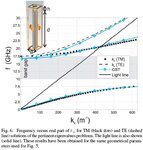jianke
Member level 3
**broken link removed****broken link removed**Hi all,
I got a simulation result of the dispersion digram for an unite cell. But some stange points are found in the dispersion digram. Anyone can help me explain it and remove them. The simulation setup of HFSS (version 13.0) is,
Solution Setup
Minimum Frequency: 1GHz;
Number of Modes: 3;
Maximum Nuber of passes: 15
Maximum Delta Frequency Per Pass: 1%
Maximum Refinement Per Pass: 20%
Minimum Coverged Passes: 2
Setup Sweep Analysis
px: linear step from 1deg to 180deg, step=15deg
Everything is fine, when the sweep starts from "15deg" to 180deg, step=15deg. However, when I change the start "15deg" to "1deg" or "0deg" or "10deg", some strange points appear. Please find them in the picture (in the red circles), discreted and continued versions are provided.


I got a simulation result of the dispersion digram for an unite cell. But some stange points are found in the dispersion digram. Anyone can help me explain it and remove them. The simulation setup of HFSS (version 13.0) is,
Solution Setup
Minimum Frequency: 1GHz;
Number of Modes: 3;
Maximum Nuber of passes: 15
Maximum Delta Frequency Per Pass: 1%
Maximum Refinement Per Pass: 20%
Minimum Coverged Passes: 2
Setup Sweep Analysis
px: linear step from 1deg to 180deg, step=15deg
Everything is fine, when the sweep starts from "15deg" to 180deg, step=15deg. However, when I change the start "15deg" to "1deg" or "0deg" or "10deg", some strange points appear. Please find them in the picture (in the red circles), discreted and continued versions are provided.


Last edited:
